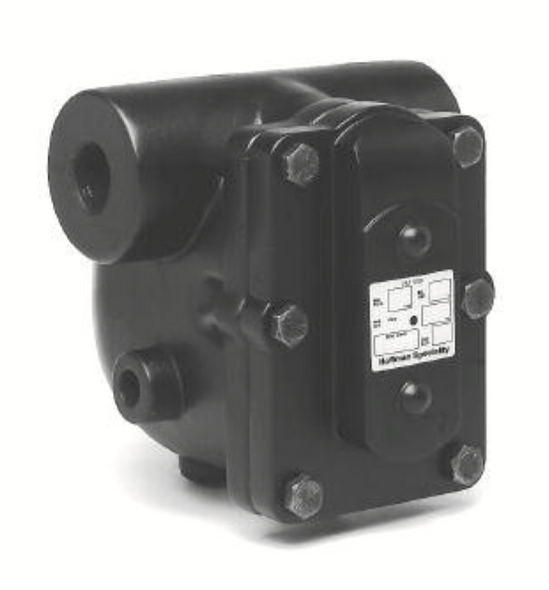Hoffman
404274 Hoffman FT030I-4 1" Float & Thermostatic Steam Trap
- MPN:
- 404274
- Condition:
- New
- Availability:
- This Item Usually Ships The Same Day!
- Shipping:
- Calculated at Checkout
Description
404274 Hoffman FT030I-4 1" Float & Thermostatic Steam Trap.
Information:
- Hoffman Specialty General Catalog
- Hoffman Specialty Service Parts Catalog
- Hoffman Specialty Bear Trap Series H, C & X Steam Traps Instruction Manual
- Hoffman Specialty Float & Thermostatic Steam Traps Series C & X Submittal Sheet
- Hoffman Specialty Float & Thermostatic Steam Traps Series I Submittal Sheet
Float and Thermostatic Traps:
Automatic and continuous elimination of condensate and air at steam temperature increases system efficiency. Float and thermostatic traps operate on the density principle. A thermostatic vent in the top of the trap allows free passage of air during start-up, and closes near saturation temperature. Condensate fills a float chamber, causing a float to rise, and through a lever mechanism pulls a valve off its seat and opens the orifice of a discharge valve. The opening and closing of the seat provides modulation to handle light or heavy condensate loads.
The discharge valve is under condensate water. The water forms a seal that prevents live steam loss. This also prevents the venting of air and non-condensable gases. The accumulation of air and non-condensable gases causes a significant temperature drop. The thermostatic valve in the top of the trap discharges these gases.
Operation of Float & Thermostatic Traps:
During start-up, the thermostatic vent is open to allow free passage of air. A lever connects a ball float to a valve and seat. When the condensate that fills the float chamber reaches a certain level, the float rises pulling the valve off the seat, opening the orifice of the discharge valve and draining the condensate.
The thermostatic vent will close near saturation temperature. The balanced design allows venting of non-condensables that collect in the float chamber, when operating at design pressure.
The condensate port is normally closed during no load. As condensate enters the float chamber, the float and lever mechanism movement opens and closes the seat to provide drainage equal to the condensing rate.
Characteristics of Float & Thermostatic Traps:
- Completely drains condensate at saturation temperature.
- Modulates to handle light or heavy loads, continuous discharge equal to condensing load.
- Separate thermostatic vent allows venting of air during start-up.
- Air venting reduces warm-up time and improves heat transfer.
- Modulating ports provide long life.
- Internal parts can be easily renewed without disturbing pipe connections.
- Float or bellows may be damaged by water hammer.
- Primary failure is closed
- Does not withstand freezing temperatures.
Primary Applications of Float & Thermostatic Traps:
- Heating main drip traps.
- Shell & tube heat exchangers.
- Tank heaters with modulating temperature regulators.
- Unit heaters requiring fast venting.
- Steam humidifiers.
- Steam separators.
- Steam unit heaters.
- Steam lock releases.
- Air handling coils.
- Air blast-heating coils.
- Air pre-heat coils.
- Autoclaves.
- Modulating loads.
- Fast heating start-up applications.
Features and Benefits:
- Large ports handle high capacities.
- Wide range of seat pressures available – up to 175 psig.
- Durable, cast iron bodies provide long service.
- Stainless steel valve trim, floats and air vents increase service life.
- Series H & I:
- In-line horizontal piping connections simplify installation and maintenance.
- Removable cover for easy in-line maintenance.
- Primary Applications of Float & Thermostatic Traps










